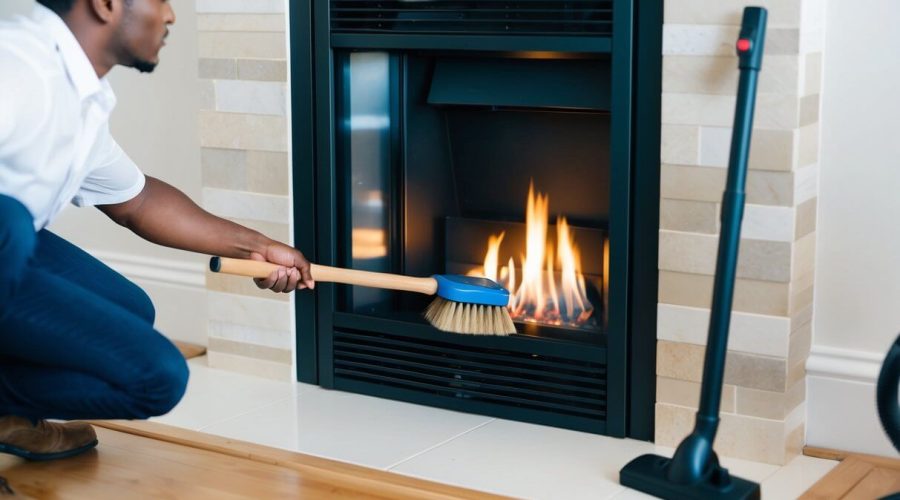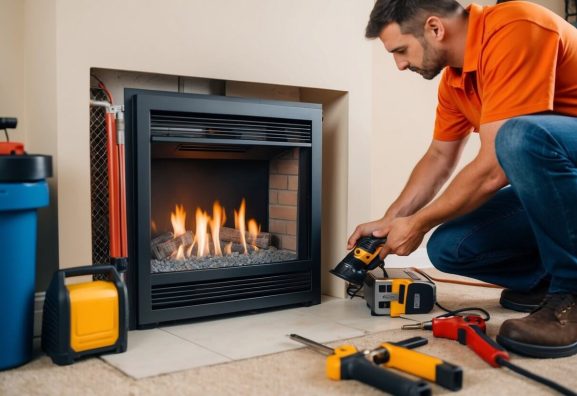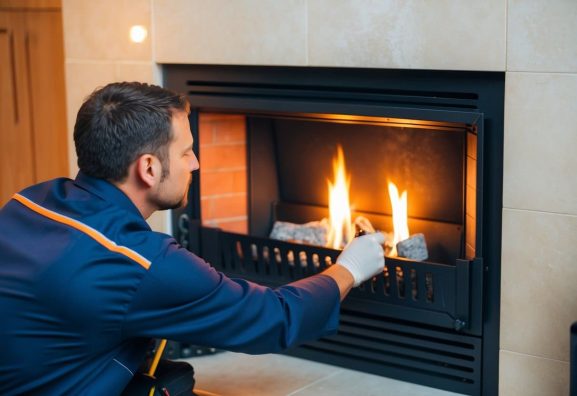When to Clean Your Gas Fireplace (Safety Guide)
Gas fireplaces offer a convenient source of warmth and ambiance, but regular maintenance is crucial for safety and efficiency. A gas fireplace should ideally be cleaned at least once a year, especially if it is used frequently. Neglecting this task can lead to reduced performance and potential safety hazards, such as carbon monoxide buildup.
Understanding when and how to clean a gas fireplace is essential for every homeowner. This not only preserves the appliance’s appearance but also ensures its function remains optimal. Cleaning might include tasks like removing debris and checking for blockages, which can prevent dangerous situations.
Staying informed about maintenance practices and knowing when to take action can enhance the longevity and safety of a gas fireplace. Keeping a regular cleaning schedule and understanding the signs that indicate a deeper clean is needed will help maintain a safe and inviting home environment.
Key Takeaways
- Annual cleaning helps maintain fireplace efficiency and safety.
- Regular maintenance prevents potential hazards like carbon monoxide buildup.
- Knowing when to clean ensures the longevity of your gas fireplace.
Understanding Your Gas Fireplace
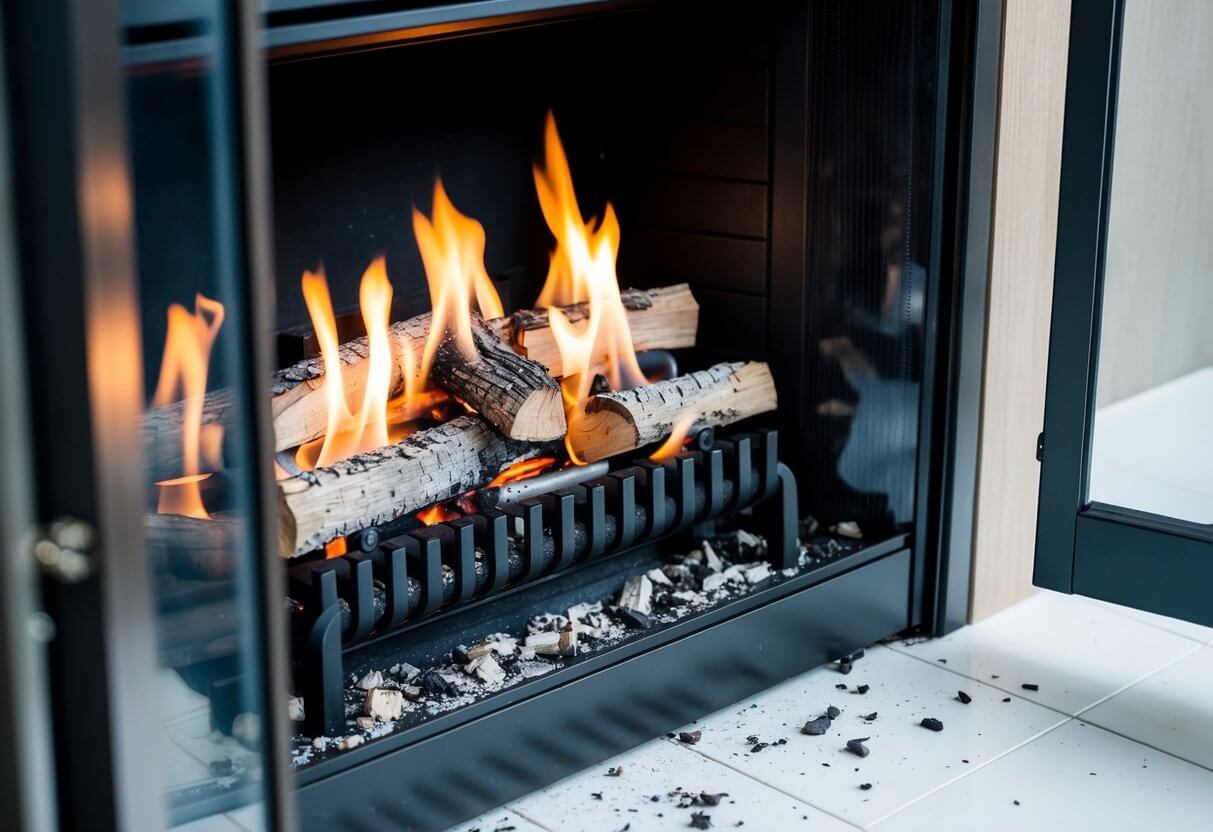
A gas fireplace consists of various components that work together to provide efficient heating and ambiance. Understanding these elements is crucial for proper maintenance. Additionally, comparing gas fireplaces to wood-burning models reveals significant differences in functionality and upkeep.
Components of a Gas Fireplace
A gas fireplace typically includes several key components:
- Gas Valve: This controls the flow of gas to the fireplace. It opens when the fireplace is turned on.
- Igniter: Responsible for producing the spark that ignites the gas. It is essential for starting the fire safely.
- Burners: These are where the gas mixes with air and is ignited, producing flames.
- Gas Logs: Designed to replicate the look of real wood, these logs can be made of ceramic or other materials that can withstand high heat.
- Ventilation System: Proper venting is critical to prevent the buildup of harmful gases inside the home.
Routine maintenance of these components ensures the fireplace operates safely and efficiently.
Gas Fireplace vs. Wood-Burning Fireplace
Gas fireplaces offer several advantages over traditional wood-burning fireplaces.
- Cleanliness: Gas fireplaces produce less mess. Wood-burning fireplaces generate ash and soot, requiring more frequent cleaning.
- Convenience: With a gas fireplace, lighting and extinguishing the fire are simpler. Many models have remote controls or wall switches.
- Efficiency: Gas fireplaces typically heat more efficiently. They provide instant heat without the time needed for wood to catch fire.
Despite these advantages, wood-burning fireplaces offer a unique charm and aroma that many homeowners appreciate. Each type has its pros and cons, influencing user preference based on heating needs and lifestyle.
Safety First
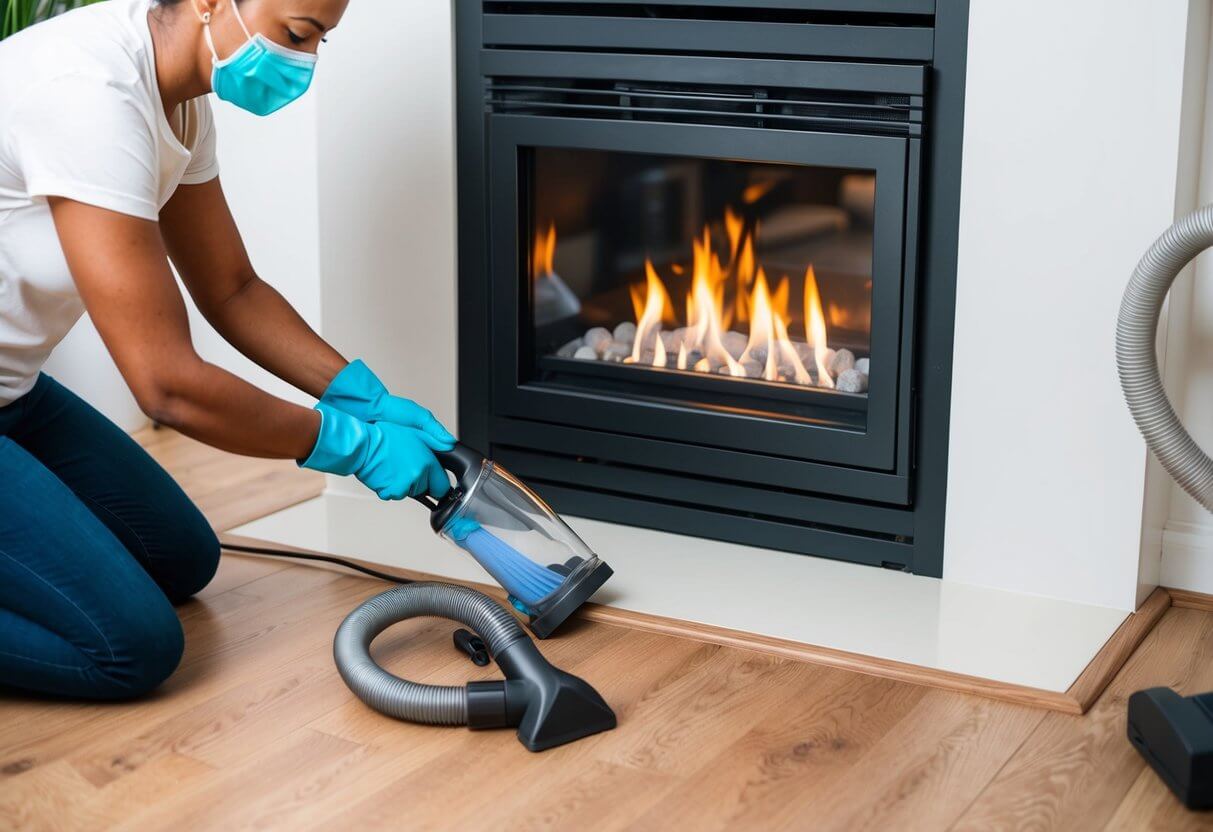
Ensuring safety during gas fireplace maintenance is crucial. Proper precautions can prevent dangerous situations such as gas leaks or carbon monoxide exposure. Essential steps must not be overlooked.
Importance of Carbon Monoxide Detectors
Carbon monoxide detectors play a vital role in safety when using gas fireplaces. These detectors alert homeowners to the presence of this odorless, tasteless gas, which can cause serious health issues or even death.
It is recommended to install these detectors near sleeping areas and on every level of the home. They should be tested monthly to ensure functionality. Homeowners should replace batteries at least once a year, and detectors themselves should be replaced every five to seven years.
When performing maintenance, ensure the gas valve is completely shut off. This action minimizes the risk of carbon monoxide buildup during maintenance activities. A clean burn in gas fireplaces typically produces lower emissions, but the potential for gas leaks remains a concern.
Regular Cleaning and Maintenance
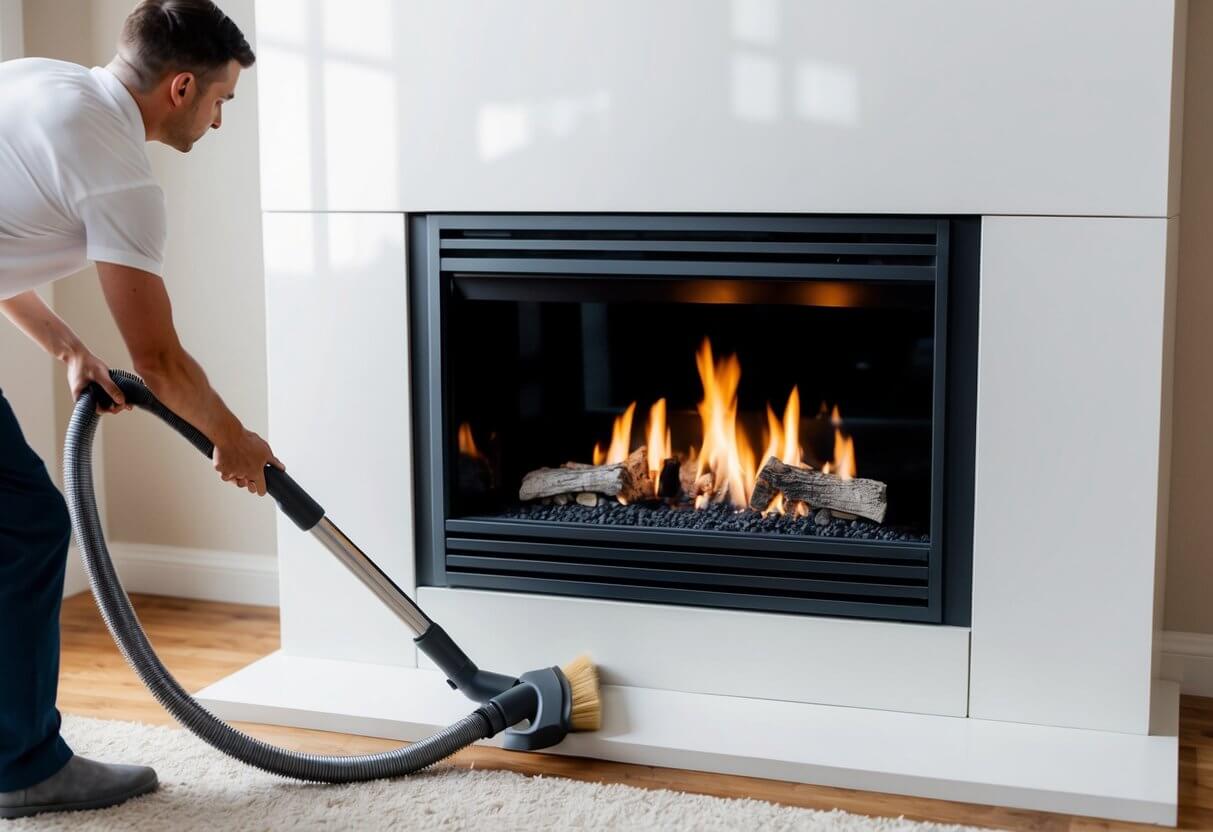
Regular cleaning and maintenance are essential for ensuring that a gas fireplace operates safely and efficiently. This involves specific cleaning schedules and appropriate tools to keep the fireplace in optimal condition.
When to Clean Your Gas Fireplace
It is recommended to clean a gas fireplace every two to four months. This frequency helps prevent the buildup of dust and dirt that can affect performance. Monthly cleanings may be necessary in high-use seasons, like fall and winter, to maintain effectiveness.
Chimney inspections should occur annually to check for obstructions. Although gas fireplaces do not produce the same soot and creosote as wood-burning models, a thorough check prevents potential airflow issues.
Tools for Cleaning a Gas Fireplace
Gathering the right tools is crucial for effective cleaning. Key items include:
- Vacuum cleaner: A vacuum with a brush attachment can efficiently remove dust.
- Spray bottle: Used for applying cleaning solutions to surfaces.
- Paintbrush: Ideal for dislodging debris from hard-to-reach areas.
Having these tools on hand enables a more thorough cleaning process. It’s also advisable to wear gloves and a mask to ensure safety while handling fireplace components.
Cleaning the Gas Logs
Cleaning the gas logs involves a gentle process to avoid damage. Begin by removing the logs carefully.
Use a soft brush or cloth to wipe them down, removing any dust or soot.
If necessary, a damp cloth can be used with mild soap for stubborn spots. Always make sure the logs are completely dry before reinserting them into the fireplace to prevent any moisture retention.
Maintaining Lava Rocks
Lava rocks are another component requiring attention. These rocks should be inspected regularly for debris accumulation.
Cleaning involves removing loose dirt and dust using a vacuum or brush.
If the lava rocks appear stained or heavily soiled, they can be rinsed with water and allowed to dry completely before returning them to the fireplace.
Regular maintenance of lava rocks ensures proper heat distribution and enhances the overall appearance of the fireplace.
Deep Cleaning Process
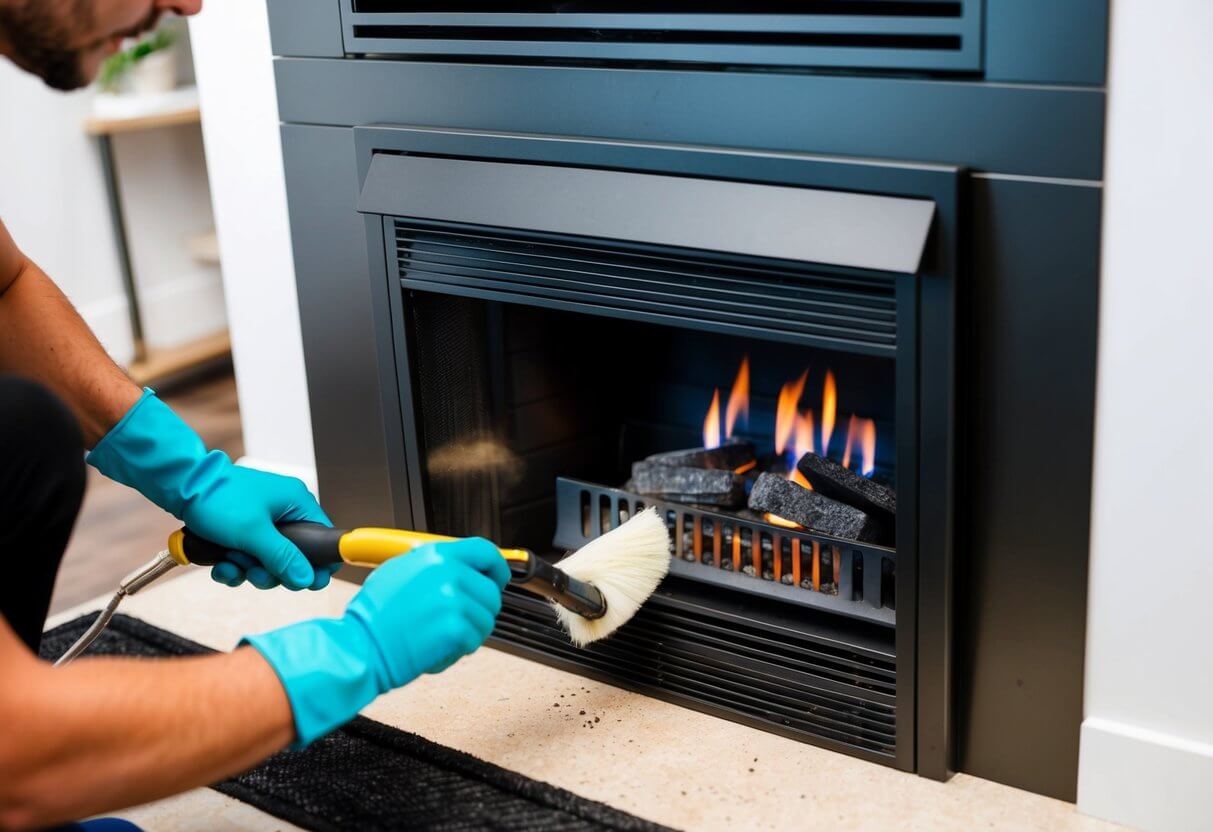
A thorough cleaning of a gas fireplace involves attention to both the glass and the exterior, as well as the interior components. The following guidelines present a structured approach to achieving a clean and safe fireplace.
Steps to Clean Fireplace Glass
Cleaning the glass of a gas fireplace is crucial for maintaining visibility and ensuring efficient operation. The first step involves turning off the gas valve and allowing the fireplace to cool completely.
Next, gather the necessary materials:
- Fireplace glass cleaner
- Soft, clean cloths
- Rubber gloves
- Drop cloth (to catch any fallen debris)
Apply the glass cleaner according to the manufacturer’s instructions. After spraying, use a clean cloth to wipe the surface in a circular motion. It’s essential to remove any built-up soot or grime, ensuring the glass is streak-free. Regular cleaning will prevent buildup and maintain clarity.
Addressing the Fireplace Exterior
The exterior of the gas fireplace requires regular maintenance to keep it looking great and functioning properly. Start by dusting off the exterior surfaces with a dry or slightly damp cloth.
For tougher stains, a mild detergent mixed with water can be used. Ensure that any cleaning agent is safe for the fireplace material.
She should also check for signs of wear or damage, particularly around connections and seals. If any issues are detected, they should be repaired promptly. It’s advisable to avoid harsh chemicals that could damage the finish. A simple routine cleaning can preserve the fireplace’s appearance and functionality over time.
Tackling Interior Dirt and Dust
Cleaning the interior of the gas fireplace is essential to maintain efficiency and safety. Start by turning off the gas and allowing the fireplace to cool.
Remove any ceramic logs and lava rocks cautiously, placing them on a drop cloth to avoid additional mess. Using a soft-bristle brush, gently sweep away dirt and dust from the burner and surrounding areas.
Vacuuming can also be effective for removing loose debris.
If residue remains, a damp cloth can be used to wipe down surfaces, ensuring they are dry before reassembling. Regular maintenance helps reduce the risk of carbon monoxide buildup, promoting a safer environment.
Troubleshooting Common Issues
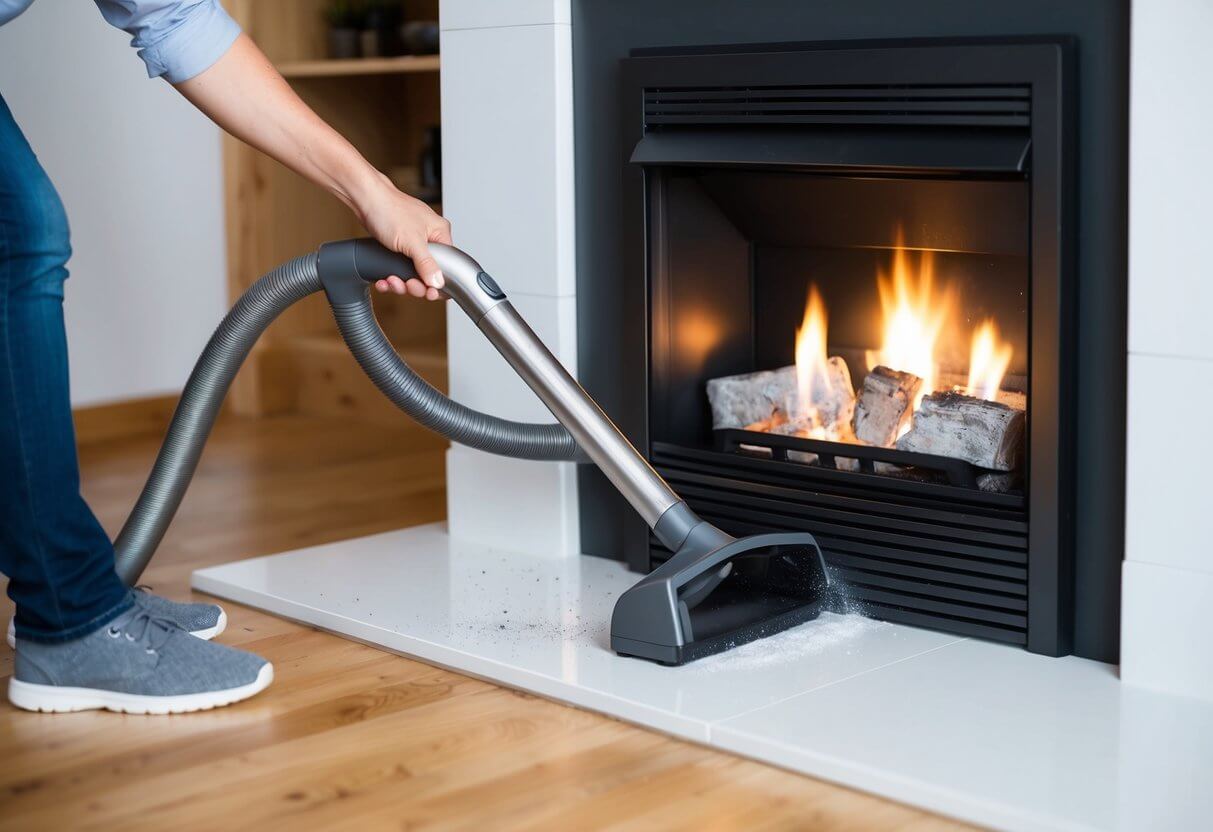
Maintaining a gas fireplace involves addressing various issues that can impair its functionality. Specific problems, such as bugs or debris accumulation, require focused solutions to ensure safety and efficiency.
Removing Bugs and Debris
Bugs and debris can obstruct the operation of a gas fireplace. This is especially common in areas where the fireplace is infrequently used. Regular inspection is key.
To remove bugs, use compressed air to clear out any build-up in the pilot light and burner areas. It’s best to do this when the fireplace is completely off and cool.
Additionally, a soft brush can help eliminate dust and larger debris. Removing decorative elements, like logs or stones, allows for a thorough cleaning of the interior. This step prevents obstructions that could impact gas flow and combustion.
Fixing Minor Gas Fireplace Problems
Several minor problems can arise with gas fireplaces that may require troubleshooting. A frequently encountered issue is a pilot light that won’t stay lit. This might occur due to a dirty pilot light tube. Regular cleaning can ensure the tube is free from blockages.
If the main burner extinguishes during operation, check for gas supply issues. Ensure that the tank has enough fuel and examine the gas inlet pressure.
For optimal operation, perform routine checks on the thermopile. Excessive carbon build-up can impact performance. If this is the case, the thermopile should be cleaned with a stainless-steel brush and sandpaper before testing its function again.
Frequently Asked Questions
Cleaning a gas fireplace is essential for safety and efficiency. Understanding the frequency, signs of need, and specific cleaning processes can help in maintaining its optimal performance.
How often should I clean my gas fireplace?
Gas fireplaces should be cleaned at least once a year to ensure they operate safely and efficiently. Regular maintenance is especially recommended before the colder months when usage typically increases.
What are the signs that my gas fireplace needs cleaning?
Signs that a gas fireplace needs cleaning include poor flame quality, unusual odors, or visible debris around the burner. An increased amount of dust and dirt accumulation can also indicate that it requires attention.
What is the process for cleaning the burner ports of a gas fireplace?
To clean the burner ports, one should first turn off the gas supply and allow the fireplace to cool. Next, remove the burner assembly and use a soft brush or compressed air to clear any obstructions from the ports.
Are there specific considerations for cleaning the vent of a gas fireplace?
When cleaning the vent of a gas fireplace, it is crucial to ensure it is unobstructed and free of debris. Checking for signs of corrosion or damage in the venting materials is also important for proper airflow.
Can I clean my gas fireplace chimney myself, and how?
Yes, a gas fireplace chimney can be cleaned by the homeowner. The process involves removing debris, dust, and potential blockages, often utilizing a vacuum or brush designed for chimney cleaning. It is advisable to wear protective gear during this process.
What risks are associated with not cleaning a gas fireplace?
Neglecting to clean a gas fireplace can lead to operational issues such as reduced efficiency and increased risk of malfunction. In severe cases, it may pose safety hazards, including gas leaks or fire risks due to accumulated debris.

